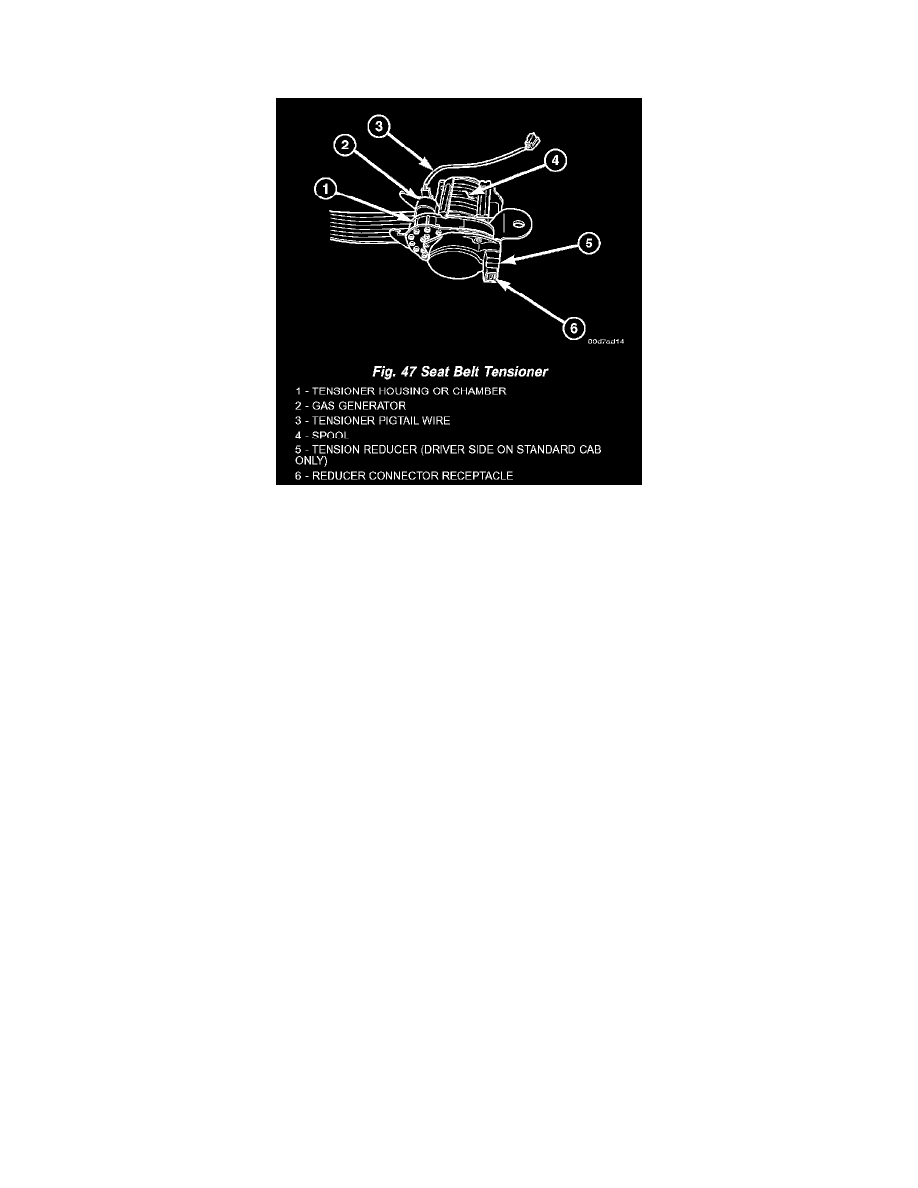RAM 1500 Truck 4WD V8-5.9L VIN Z (2002)

Seat Belt Tensioner: Description and Operation
Seat Belt Tensioner
Fig. 47 Seat Belt Tensioner
SEAT BELT TENSIONER
Front seat belt systems incorporate Tensioner Modules (SBT). At the onset of an impact event each tensioner uses a pyrotechnic device, which is
triggered simultaneously with the airbags, to rapidly retract the seat belts. With the slack removed, the occupant's forward motion in an impact will be
reduced as will the likelihood of contacting interior components. After an impact that deploys the airbag, the seat belt tensioner assembly must be
replaced.
The ACM module monitors the Seat Belt Tensioners circuit resistance and reports active and stored DTC's if any problem is found.
Front outboard seating position seat belt tensioners supplement the driver and passenger airbags for all versions of this model. The seat belt tensioner is
integral to the front outboard seat belt and retractor unit, which is secured to the inner B-pillar on the right and left sides of the vehicle. The retractor is
concealed beneath the molded plastic inner B-pillar trim. The seat belt tensioner consists primarily of a die cast aluminum tensioner housing or chamber,
a mechanical clutch unit, a tape-like metal strip, a pair of cutters, a pyrotechnically activated gas generator, and a short pigtail wire. All of these
components are located on one side of the retractor spool on the outside of the retractor housing. The seat belt tensioner is controlled by the Airbag
Control Module (ACM) and is connected to the vehicle electrical system through a dedicated take out of the body wire harness by a keyed and latching
molded plastic connector insulator to ensure a secure connection.
The seat belt tensioner cannot be repaired and, if faulty or damaged, the entire outboard front seat belt and retractor unit must be replaced. If the front
airbags have been deployed, the seat belt tensioners have also been deployed. The seat belt tensioner is not intended for reuse and must be replaced
following a deployment. A locked retractor that will not allow the seat belt webbing to be retracted or extracted is a sure indication that the seat belt
tensioner has been deployed and requires replacement. (Refer to RESTRAINTS/FRONT OUTBOARD SEAT BELT & RETRACTOR - REMOVAL).
The seat belt tensioners are deployed by a signal generated by the Airbag Control Module (ACM) through the driver and passenger seat belt tensioner
line 1 and line 2 (or squib) circuits. When the ACM sends the proper electrical signal to the tensioners, the electrical energy generates enough heat to
initiate a small pyrotechnic gas generator. The gas generator is installed at the top of the tensioner housing which contains a long metal tape that is routed
through two chambers within the housing. Each end of the tape is wound around the outer sleeve of a mechanical clutch mechanism secured to one end
of the torsion bar upon which the retractor spool is secured. As the gas expands, it is directed against the metal tape within the two chambers of the
housing causing the tape to unwind from the clutch sleeve. As the clutch rotates it engages the torsion bar, which drives the seat belt retractor spool
causing the slack to be removed from the seat belt.
Once a seat belt tensioning sequence has been completed, the forward momentum of the occupant results in deformation of the torsion bar. As the torsion
bar deforms it allows the seat belt webbing to unwind from the retractor spool, which causes the metal tape to be wound back onto the clutch sleeve until
it is pulled tight against two cutter blades within the housing, which immediately cut the metal tape.
Removing excess slack from the seat belt not only keeps the occupant properly positioned for an airbag deployment following a frontal impact of the
vehicle, but also helps to reduce injuries that the occupant might experience in these situations as a result of a harmful contact with the steering wheel,
